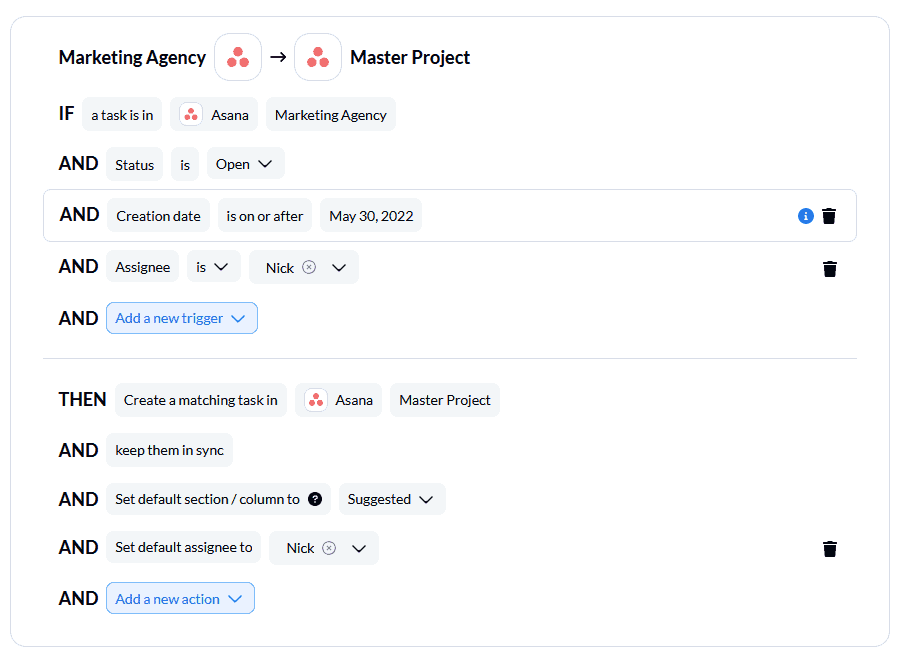How to Build a Master Project in Asana Between Organizations
Asana is one of the most powerful project management tools out there. Among its greatest strengths is the ability to multi-home a single Asana task in multiple projects, meaning you can follow its progress no matter which project you work from. Send a task to a stakeholder’s private project, and they’ll get updates in real-time. Multi-home a support ticket into a development roadmap, and everyone will have all the context they need.
But what happens when you’re part of multiple Asana workspaces? Asana doesn’t have a great way to handle this natively; to manage tasks across workspaces you need to constantly switch back and forth between them. But if you use Unito, you can build flows that centralize all your Asana tasks into a single workspace. No more going through dropdowns.
When do you need an Asana master project?
Streamlining agency work
Agencies can end up becoming victims of their own success. The more successful they are, the busier they get, and the harder it gets to keep track of all their clients. If they’re lucky enough to have all their clients in Asana, they still have a big challenge to overcome: managing multiple Asana workspaces.
When you’re dealing with potentially sensitive information, you have to make sure the work you do for each client is kept separate. That means having to jump between Asana workspaces. But with an Asana master project, agencies can centralize work from multiple clients — without sacrificing security or privacy.

Bryan Bennett is the CEO and Founder of TheKickstart.com, an agency that helps its clients get started in Asana and optimize their workflows. As part of his work, Bryan had to manage tasks across more than 30 Asana workspaces. That meant every single week started with hours spent clicking back and forth between workspaces to plan ahead. But with Unito, Bryan can sync all his Asana tasks into a single project, cutting hours of busywork out of his week.
Simplify freelancer coordination
Working with freelancers is a great way to shore up some of the gaps in your team without hiring for a full-time role. But knowing just how closely you should work with freelancers — and how much of your Asana projects they should see — is always a challenge. Too little, and they can’t really do their job. Too much, and you’ll overwhelm them.
So instead of having to hop back and forth between the Asana workspaces you build for each freelancer — or worse, lose an Asana seat to have your freelancer in your workspace — you can use an Asana master project. That way, any tasks your freelancers are working on can be synced to the Asana project of your choice, even if they’re not assigned to you.
Harmonize to-dos from multiple sources
Maybe you’re a freelancer yourself. Maybe you’re working closely with another company on an important project. Either way, you find yourself with Asana tasks you’re responsible for scattered across multiple workspaces. Whenever you have to plan your workday, you have to make sure you’re not missing any tasks — and that means going through a ton of projects.
But with Unito, you can keep all your to-dos in one place. You can use filtering rules to make sure only tasks assigned to you are synced to your Asana master project. That way, you don’t have to worry about affecting anyone else’s work in the multiple workspaces you’re a part of.
How to build an Asana master project
Step 1: Set up your master project
Before you start building your first Unito flow, you need to set up the project that’ll centralize all your tasks. That project will look very different depending on your use case. If you’re building a master project to manage agency clients, for instance, you’ll probably want a custom field that labels each task according to which client it’s from. If you’re managing your own to-dos, a field for estimating the time each task will take might be more important.
Step 2: Sign up for Unito
Unito’s Asana integration is the de facto choice for syncing Asana tasks from multiple projects to a single master project. That’s because it automatically maps most fields for you, lets you filter out irrelevant tasks, and integrates with the other tools in your stack. You can try it for free right here.
Step 3: Create your Unito flow
Time needed: 10 minutes
Building your Unito flow is super simple, and you can do it in just a few minutes. Here’s all you need to do.
- Connect your Asana account and pick your projects

- Build your rules

- Map your fields

- And launch

And just like that, you’ve built a flow that connects one Asana project to another. When you want to build more, all you need to do is duplicate the flow you’ve already created, and Unito will keep your settings intact. All you’ll need to do is pick the new project you want to connect.
Want a more detailed guide for building this flow? You’ll find that right here.
Master your projects
No one should have to spend hours clicking through multiple Asana workspaces just to figure out what they need to work on. With Unito, that can be a thing of the past. Sign up for your free trial, build your first flow, and see what a Unito integration can do for your workflows.

